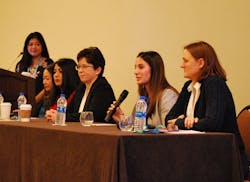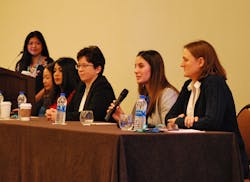Inclusivity & innovation over oatmeal
“I am a nerd,” said Stacy Keeling, proudly, during her introduction for the Women in Innovation breakfast panel at Emerson Exchange Americas this week in Grapevine, Texas. Two of her fellow panelists also—confidently—labeled themselves as nerds during their introductions. And the other panelists boasted multiple academic degrees and impressive work histories that similarly fit that label, which, based on the applause that followed Keeling’s admission, has clearly evolved from a slur to a point of pride.
There was an abundance of smarts gathered on this dais. And there was an early morning audience eager to learn from these panelists about the unique challenges and emerging opportunities for women working in the modern industrial arena.
Pass the oatmeal, get inspired.
And that doesn’t benefit anybody.
So how do industrial enterprises encourage inclusivity? How do they promote diversity at every level? Some of the tactics discussed here today are high-level. Supporting STEM programs early in the educational system is critical, this panel agreed. And networking events like this one educate and encourage attendees—female and male—to be more cognizant of inequalities and to consider methods to make changes.
Other corrective tactics are much more granular. Golder explained how at corporate functions she will purposely insert herself into all-male clusters of executives and make them aware of their homogenous socializing. “Sometimes you must remind people that things might look differently from different perspectives,” she explained.
McClintock recommended weekly team meetings that focus on bonding as much as knowledge-sharing and project updates. When teams have just one woman, teamwork is even more necessary to nurture inclusivity. Keeling added the importance of resiliency, particularly during what she labeled stretch assignments—starting a new project or after a new promotion. Maintaining internal resilience during these challenging periods is required—trust that you can overcome, she said—but so too is the ability to rely on a network of peers and mentors. Veteran female executives in the industrial world can offer life-changing guidance. Sometimes they’re so focused on their own journeys that they need to be directly asked to provide it. “Tell them you are inspired by them and you want to learn from them,” stressed Golder.
McCartney made an interesting observation about the lessons to be learned from global teams—how international collections of coworkers can prompt a more global, more inclusive mindset back at the home office in, say, Decatur, Illinois.
“Inclusivity must be intentional,” explained Malhotra, noting how it might not occur organically. Added Keeling, “And it is something that each of us in this room can impact.”
The audience and panelists here are aware of the mountain yet to climb in terms of developing workforces that mirror society. The panel referenced the latest World Economic Forum report that predicts the gender gap will not close for another 130 years. But while diversity—from boardrooms to plant floors—is improving (not quickly enough), there might be a larger shift in this space that could accelerate progress. Consider digital transformation, which is changing the nature of work in ways that might particularly suit female personnel.
“Remote work definitely levels the playing field in many ways,” explained Malhotra. “And flexibility allows women professionals to do more,” added Golder.
As an example, McCartney referenced her own history on the plant floor. “From the manufacturing perspective, with automation and digitalization we are now looking differently at our workforces. We can now work smarter, not harder.” She shared an anecdote about literally hanging on valves to pry them open as a young operator. “Those processes can be automated now, which creates spaces for women to thrive with tasks that they were, previously, not able to physically do. We can now focus on cross-functional areas with digital and automated approaches, which enables us to excel.”
Excelling they are. These accomplished, inclusive-minded, professional women—who label themselves as nerds among other titles including director and vice president—are proving that opportunities expand as they diversify.
Get the best of Emerson Exchange Americas 2022
When the event comes to a close, the best, most important coverage will be compiled into a report. Register now to pre-order the report and be among the first to receive it in your inbox.
About the Author
Chris McNamara
Smart Industry

Leaders relevant to this article:

